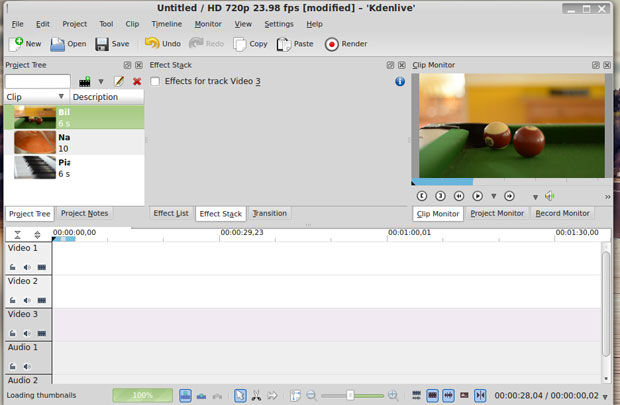Kdenlive is a multitrack, nonlinear video-editing suite packed with some of the most recent video technologies. This application can be a great tool if you have serious video work to do, but you need to fully test it before attempting any mission-critical editing tasks.
Kdenlive requires some effort to learn. That’s especially true if you have little experience with other video-editing software. Kdenlive might be too much to take on as an entry-level editing tool.
If your hardware can tolerate its sometimes-finicky demands, however, Kdenlive can be a very productive next step from whatever else you are using now. Once you master its many features, Kdenlive can serve uses ranging from basic video editing to semi-professional work.
What It Does
Kdenlive lets you mix video, audio, and still images from different types of media. Mixing tasks are made easier with custom profiles, which include resolutions, frame rates, PAR, and DAR.
The multitrack provision has a timeline feature that allows an unlimited number of video and audio tracks organized in layers.

Kdenlive lets you mix video, audio, and still images from different types of media.
You can create, move, crop, and delete video clips, audio clips, text clips, and image clips. You can also configure keyboard shortcuts and interface layouts.
Kdenlive provides a wide range of effects and transitions. It allows you to add custom effects and transitions. It is built around a nonblocking rendering system using a separate rendering application. You can stop, pause, and restart rendering.
An Impressive Tool Set
Kdenlive supports a wide range of codecs and formats, including DV (PAL and NTSC), HDC, AVCHD, lossless video (SNOW lossless codec, etc.), and Ogg Vorbis as well as some high-quality types such as mpeg4 and h264. You can export to any format supported by FFmpeg: MPEG, avi, DV, flash, ac3 audio, and mov.
You can also export to Internet websites like Dailymotion, Vimeo, and YouTube using presets. A handy addition is the ability to export your edited film to mpeg2 and 3 to create DVDs.
Kdenlive relies on several other open-source projects, such as FFmpeg, the MLT video framework, and Frei0r effects. This design is significant for higher-end video editing results.
MLT is the video-rendering engine that lets Kdenlive display and manipulate video clips. It is a multimedia framework designed for television broadcasting to provide real-time effects. Frei0r is a minimalistic plug-in API for video effects.
Version-Intensive
The latest version of Kdenlive is 0.9.6, released in April. Do not trust the earlier versions most distro repositories currently distribute — even the developers warn that these outdated versions are far too buggy and crash-prone.
You might be willing to tolerate this poor performance from an earlier version, but you will also miss out on some of the impressive refinements in the latest version.
So go to the download site to get the latest version of Kdenlive.
Installing Kdenlive
The need to rely on the developer’s website for your distribution path makes installing Kdenlive a bit of a hassle. Use these commands in a terminal window to get the latest version updated:
- sudo add-apt-repository ppa:sunab/kdenlive-release
- sudo apt-get update
- sudo apt-get install kdenlive
I experienced no issues during this first phase of the installation process, but the first run produced a couple of glitches.
Kdenlive uses an automated setup and configuration process. It is a nice touch and eliminates the need to find and mesh all of the system components that support audio and video on different computers.
First, I needed to install xine video player to preview video DVDs. That package was available through the Ubuntu/Linux Mint software updater. Second, my test computer had MLT 0.8.0 installed. I needed to get MLT 0.8.8.
I followed a few links from the developer’s website to track down a tarball of the needed library, but I luckily had my distro’s software updater refresh. That gave me an easy way around manually installing the MLT update.
Special Needs
Plugging in my video cam and then my camcorder brought me unexpected disappointments. Connecting each one caused progressively worsening system sluggishness and, ultimately, lockup. That is because Kdenlive requires a FireWire connection to use live video-capture devices.
Another hardware factor to consider before getting comfortable with Kdenlive is the need for relatively recent computers. Older gear will not give you a pleasant user experience.
For the best results with light to moderate editing work in Kdenlive, the developers recommend 32-bit or 64-bit computers with a modern processor such as AMD 64 or Intel mono/dual-core systems. Also essential is a fast hard disk with more than 20 GB of free space and at least 1 GB of RAM.
For advanced use and semiprofessional work, they recommend a recently built computer with an AMD Phenom quad-core processor and 4 GB of RAM. Also suggested is a three-SATA disk for RAID-5 usage and a recent video card with a dual display.
For what it is worth, most Linux distributions offer RAID-5 support.
Cluttered Interface
The overall app interface is not much different than the interfaces other video editors use, but Kdenlive has so many integrated components that its interface uses every available bit of screen and menu space. That, in part, reduces the space available for the viewing screen.
The cluttered menu results from squeezing in numerous rows to display video and audio tracks. Then, add several rows of toolbars and drop-down menus.
Even most of the drop-down menus are bursting with options and cascading sub-menus. That all takes a toll on creating a busy appearance.
Using It
Despite my familiarity with video-editing software, Kdenlive required me to do something that I rarely do in familiarizing myself with a new software product: I actually had to learn how to use it.
Choose your download option carefully. One option does not provide documentation, so that was my dilemma. I had to spend considerable time browsing through the user manual on the developer’s website.
Despite claims that Kdenlive is very intuitive, I found it to have a moderate learning curve — if for no other reason than that, many of the menu items produced different results than I expected.
For example, I was looking for a menu or toolbar icon to import video clips or open a video file from a hard drive or USB storage. Instead, you must first create a video project and save it in Kdenlive’s resident format for the open commands to load an existing file. It took me a while to figure out that I had to use the Project/Add Clip menu option to load an existing file.
Bottom Line
Kdenlive can be a very productive video editor. It can be an especially good choice for near-professional results.
However, plan to spend some time learning how to use it before trashing your current video editor. Also, consider the cost factor.
Even though Kdenlive is open source and thus free software, you will need a suitably powerful computer to handle high-end video editing tasks. The buy-in price for new hardware may be a deal-breaker.
Suggest a Review
Is there a Linux software application or distro you’d like to suggest for review? Something you love or would like to get to know?
Email your ideas to me, and I’ll consider them for a future column.
And use the Reader Comments feature below to provide your input!
























































As per your usual (outstanding) style, you can be counted on to provide all the information needed in order for one to understand completely all ramifications of using whatever it is you’re writing about.
Thanks very much; I’m just getting started in the use of video processing, and this sounds a BIT overwhelming–you, with all your experience, seemed to find it daunting.
Would you mind suggesting and reviewing a package which we first-timers would like; one which delivers the most capability while being the easiest to use?
Thanks again for your great expository, clear style, and best regards…